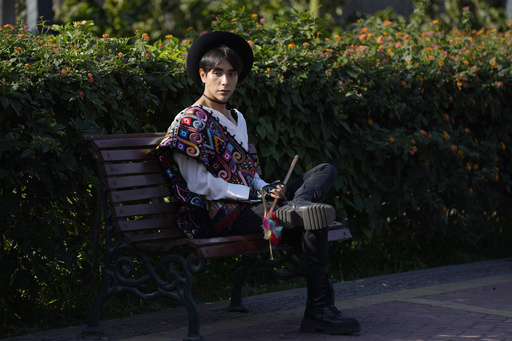LIMA, Peru (AP) — What happens when you take Quechua, the most widely spoken Indigenous language in the Americas, and fuse it with K-pop, the global musical sensation with roots in South Korea?
Ask Lenin Tamayo, who has become a social media phenomenon with “Q-pop” and released his first digital album this week.
Tamayo grew up listening to his mother, a Peruvian folk artist who sings in Spanish and Quechua, a language shared by 10 million speakers in countries including Peru, Ecuador, Colombia, Brazil, Bolivia, Argentina and Chile. As a teenager, K-pop became his passion and helped him find a group of like-minded female classmates who helped fight the bullying he says he faced at school for his Indigenous looks.
Now himself a musician, the 23-year-old Tamayo has fused those chapters, mixing Spanish and Quechua lyrics with K-pop beats to create Q-pop (in which the “Q” stands for “Quechua”). He’s amassed more than 4.4 million likes on his TikTok account and released five digital singles online.
Making music in his native language “helps embrace the roots but, without being oblivious to modernity and globalization,” he told The Associated Press in a recent interview.
For Tamayo, the K-pop aesthetic helped influence a personal style where he mixes his own choreography and a way of acting that helps reinforce a key message: Love and freedom.
“Love to unite people and the freedom to be oneself, because it’s all about embracing existence and seeking a full, full, real life, with depth,” he says.
After completing his psychology studies at the Universidad Nacional Mayor de San Marcos, Tamayo could not picture himself practicing that profession. He wanted to be a singer, and he wanted his music to mix his passions.
“Why can’t I transfer this K-pop experience to Andean music?” Tamayo said while practicing dance steps at his home in a Lima suburb.
Tamayo is the only child of Yolanda Pinares, a talented contemporary Andean music singer who taught him the importance of showing his Quechua identity in a country where racism “is covered up,” he says. When he was a child, he says he was bullied at school for being shy and for having a thin complexion, long eyes, straight black hair, and sharp cheekbones.
These traits, he believes, are somewhat similar between Andean youth and South Korean singers, something that has helped K-pop become popular even in remote villages and on the outskirts of Lima, where millions of people with Indigenous roots live.
“Art is a vehicle to move consciences and generate change,” said Tamayo, who this week released “Amaru,” his debut album in digital format. “Amaru” means snake in Quechua, a word that is tied to the history, lyrics, music, mythology of the Incas and modern sounds.
In a preview video for “Amaru,” policemen are seen beating protesters carrying a Peruvian flag and then chasing a woman who escapes through an Andean forest. The scene evokes a fresh memory of the recent citizen protests demanding the resignation of President Dina Boluarte that have left 67 dead, the majority of whom are of Indigenous origin.
Like thousands of Peruvians, Tamayo participated in the protests at the beginning of the year in the capital.
“It’s very important to make this type of music because it allows you to generate change and generate hope in young people,” he said.

 Trump order ending federal DEI programs leaves agencies and stakeholders on uncertain ground
Trump order ending federal DEI programs leaves agencies and stakeholders on uncertain ground
 Man out on bond faces new charges for allegedly beating woman with bat
Man out on bond faces new charges for allegedly beating woman with bat
 Deputies: Man admits to sexually battering young child, recording video for social media
Deputies: Man admits to sexually battering young child, recording video for social media
 EU switches defence summit venue for security reasons
EU switches defence summit venue for security reasons
 Argentina economy expands for first time since middle of last year
Argentina economy expands for first time since middle of last year
 Trump says he is not sure US should be spending anything on NATO
Trump says he is not sure US should be spending anything on NATO
 OpenAI unveils tool to automate web tasks as AI agents take center-stage
OpenAI unveils tool to automate web tasks as AI agents take center-stage
 Left-hander A.J. Minter and Mets finalize 2-year contract
Left-hander A.J. Minter and Mets finalize 2-year contract
 Brighton couple chooses terminally ill dog as their wedding witness thanks to CO marriage laws
Brighton couple chooses terminally ill dog as their wedding witness thanks to CO marriage laws
 Dave Coulier's wife Melissa talks 'Full House' star's battle with cancer, leading women's wellness seminars
Dave Coulier's wife Melissa talks 'Full House' star's battle with cancer, leading women's wellness seminars








